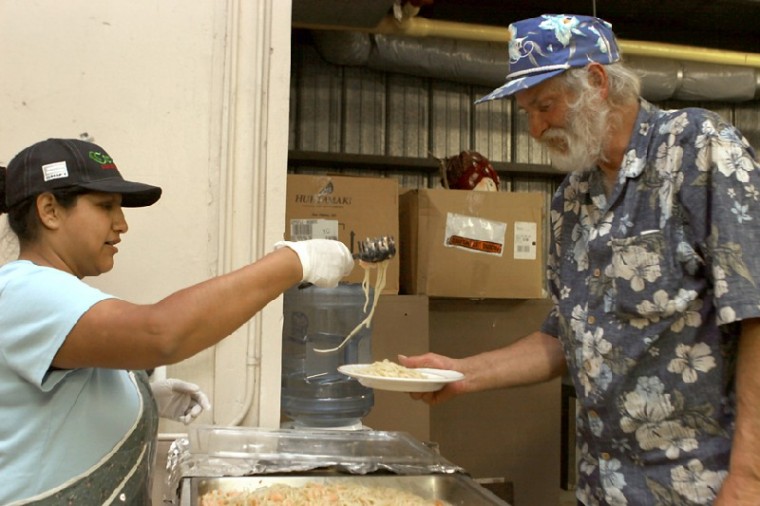
Local shelter eyes future as it ends its season
Small knots of men cluster under a darkening sky, relaxing on
small chairs, huddling against the chill. They’re waiting for a
shower, a hot meal, a warm bed and the safety and comfort of a
place to call home
– even if only for a night or two.
Local shelter eyes future as it ends its season
Small knots of men cluster under a darkening sky, relaxing on small chairs, huddling against the chill. They’re waiting for a shower, a hot meal, a warm bed and the safety and comfort of a place to call home – even if only for a night or two.
The San Benito County Homeless Shelter closed for the season a few minutes before dawn on Wednesday. It reopens the Monday after Thanksgiving next fall.
About 15 members of the community visited the shelter last week, touring its immaculate sleeping quarters and gathering at picnic tables to hear presentations about the Southside Road operation that just finished its second winter of operation.
The goal of the shelter staff and board of directors was to heighten interest in the shelter and get more assistance from the community, including an expanded board of directors.
The shelter only operates through the cold, damp months because the same area is also used as the county’s migrant workers’ camp.
A few migrant workers were already moved in. They stayed warm gathered around a barbecue, waiting for their own dinner to cook.
Phil Barrett, owner of Flapjack’s Country Cafe, showed up to donate dinner for the residents of the homeless shelter for the night.
“Look at these photographs,” said Leigh Dietz, the shelter’s new executive director, as she pointed to snapshots on a filing cabinet. “These are some of our success stories. Notice they’re just like us. They’re not green.”
Success is defined differently for every client. Some arrive after growing estranged from their families. Several residents patched things up and returned home. Others are seeking counseling for personal issues or working toward employment.
Dietz bubbles over with enthusiasm. Before taking the executive director’s job, she was site director, so she is no stranger to the place. Her new title – and new responsibilities for conducting more community outreach – reflect the maturing of the umbrella agency that runs the shelter, the San Benito County Homeless Task Force.
As Barrett bustled over glazed carrots in the Health Department-certified commercial kitchen that adjoins the dining room, visitors got the pitch last week.
The board has shrunk from seven members to five even as the shelter staff and current board lay plans for bigger things in the future.
And the future may take a familiar shape. Sobrato Transitional Apartments in Gilroy are the centerpiece of a program that offers housing for families for a year, provided they commit to job counseling and comprehensive training that helps ensure they will not end up on the streets when they leave. A year-round emergency shelter has yet to be constructed on the site.
“Sobrato has an individual plan for each family, and each person also has an individual plan,” said Kathy Ruiz, a member of the local shelter board. “It’s a whole year of intensive training for the whole family.”
More than offering a place to go each evening, the local shelter group’s goal is to mirror Sobrato’s more comprehensive program, Ruiz and Dietz agreed in an interview this week.
The shelter now can only admit adult men and women, who are clustered in a suite of adjoining rooms, three of which contain beds, arranged in bunks. Step into the brown bungalow, and a bright space opens. An open office sits near the entrance, and directly behind that is a pleasant room, filled with couches, a large-screen television and a small library.
The shelter was modeled after one that’s in the Gilroy National Guard Armory, which serves as an emergency winter shelter.
“At first, I really dreaded going,” Ruiz said, of her first visit to the Gilroy shelter. She said she was not sure what to expect. “I found it’s a happy place.”
The task force arranged visits for local politicians and that did it; “no one was opposed,” Ruiz remembered.
In fact, the shelter operated through its first two years with the support of a Community Development Block Grant obtained with the cooperation of the county. The grant is now exhausted.
Some counseling services are also available through volunteers who visit the shelter.
The rules for a place to stay are simple. Knives are checked at the door. Drugs and alcohol are off-limits. Clients are assigned a bed, and returning visitors can count on a different bed each night, just so nobody begins to think of a certain spot as his or hers.
Most arrive on San Trans right at 6 p.m. Clients get a pass to and from the shelter each day. They must leave when the buses start running again at 6 a.m. each day, right after a hot breakfast is served.
Long-term goals include a family shelter where children can be housed with their parents. The task force group also hopes to eventually find a location closer to downtown Hollister and its service network.
The local shelter operates on a budget of just $75,000 a year, built on a combination of grants, donations and fund-raisers.
Two paid staff are on hand from 6 p.m. to 6 a.m., the hours the shelter operates. A security guard walks the premises. The shelter also pays rent of $125 per night to the local Farm Labor Association.
But much of what keeps the shelter running is the kindness and generosity of others. Food is supplied by volunteers, mostly church groups and local organizations.
In 2005-2006, 328 volunteers contributed 1,456 hours of work. Most of the communities 34 churches pitched in.
There’s also an informal support network.
“A lot of organizations are talking and collaborating,” Dietz said, citing the local YMCA, Chamberlain’s Children Center, Second Harvest Food Bank and Community Pantry. The staff at the County Jail does laundry for the shelter.
Asked for unmet needs, Dietz is quick with a list.
The shelter especially needs to equip its kitchen. Institutional sized pots and pans – enough to feed 45 to 50 people – are a critical need. The small bottles of toiletries supplied by hotels and motels are needed, and there’s a constant demand for paper products.
And there’s always money.
Donations may be sent directly to the San Benito County Homeless Task Force at Post Office Box 2710, Hollister, CA 95024. People interested in volunteer opportunities may call Dietz at 801-9531.
The group also is participating in a “Jazz Under the Stars” fund-raiser on July 21 at Ridgemark Golf and Country Club.
Tables may be reserved by calling Dietz.









